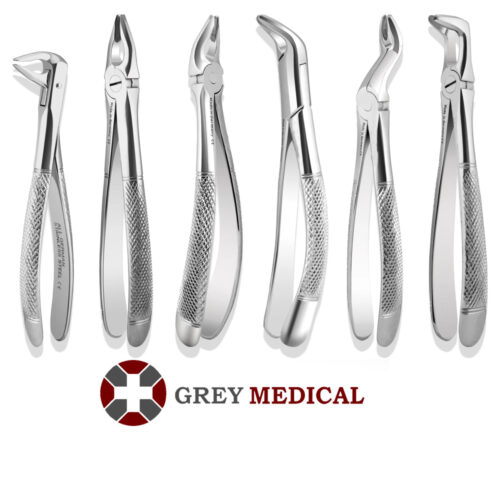Cotton Forceps in Dentistry: Essential Instrument for Precision Handling
Cotton forceps are a fundamental instrument in dental procedures, playing a crucial role in maintaining a sterile and efficient working environment. These forceps are specifically designed to handle small items such as cotton forcep dental pellets, gauze, and other materials without direct hand contact, ensuring that the sterile field remains uncontaminated. Used widely in restorative, endodontic, and general dental procedures, cotton forceps are an essential tool for every dental professional. Their design, variations, and applications make them a versatile and indispensable part of modern dental practice.

Design and Structure of Cotton Forceps
Cotton forceps are designed with precision and functionality in mind. They typically feature a long, slender body with either straight or curved tips, allowing easy access to different areas of the oral cavity. The tips may be serrated or smooth, depending on their specific use, providing a secure grip on materials. Most cotton forceps are made of high-quality stainless steel, ensuring durability, resistance to corrosion, and the ability to withstand repeated sterilization.
Another distinguishing feature of cotton forceps is the presence of locking or non-locking mechanisms. Locking cotton forceps allow dentists to hold materials securely without continuously applying pressure, reducing hand fatigue during prolonged procedures. Non-locking forceps, on the other hand, provide greater flexibility for quick and precise handling of materials. The ergonomic design of these instruments ensures ease of use, allowing for controlled and accurate placement of cotton rolls, gauze, and other small objects within the oral cavity.
Types and Names of Cotton Forceps in Dentistry
Cotton forceps come in various designs, each tailored to specific dental applications. Some of the most commonly used cotton forceps in dentistry include:
1. College Cotton Forceps
College cotton forceps are one of the most frequently used dental forceps. They feature a long, angled tip, allowing easy access to the posterior regions of the mouth. The tips are often serrated, ensuring a firm grip on materials such as cotton rolls or gauze. These forceps are particularly useful in placing and retrieving materials during restorative and endodontic procedures.
2. Curved Cotton Forceps
Curved cotton forceps are designed with a slight bend in the tip, which enhances their ability to reach difficult areas within the mouth. This design is especially beneficial for procedures involving the back teeth, where precision placement of materials is required. Their curved shape provides improved visibility and control, making them ideal for delicate dental tasks.
3. Straight Cotton Forceps
Straight cotton forceps have a simple, linear design that allows for straightforward handling of cotton pellets, gauze, and other materials. They are commonly used for general dental procedures where accessibility is not an issue. The smooth or serrated tips ensure that materials are securely held without slipping.
4. Locking Cotton Forceps
Locking cotton forceps are equipped with a mechanism that allows them to hold objects securely without requiring continuous pressure from the dentist’s hand. This feature is especially useful in procedures where materials need to be held in place for an extended period, such as in root canal treatments or cavity preparations.
Applications of Cotton Forceps in Dentistry
Cotton forceps play a vital role in a variety of dental procedures, ensuring that small materials are handled safely and hygienically. One of their primary applications is the placement and removal of cotton rolls and gauze, which are used to absorb saliva and maintain a dry working area. Keeping the treatment area dry is crucial for procedures such as fillings, crowns, and sealants, where moisture can compromise the integrity of dental materials.
In endodontic procedures, cotton forceps are used to place medicated cotton pellets into root canals. Since root canal treatments require a high level of sterility, the use of cotton forceps prevents contamination of the treated area. Additionally, these forceps are used for retrieving objects from the oral cavity, such as temporary restorations, excess materials, or small instruments.
Sterility is a top priority in dentistry, and cotton forceps contribute significantly to infection control. By allowing dentists to handle materials without direct contact, they reduce the risk of cross-contamination between the patient, the instruments, and the dental professional. This is particularly important in maintaining high standards of hygiene in modern dental practice.
Benefits of Using Cotton Forceps in Dental Procedures
Cotton forceps provide numerous benefits that make them an essential tool in dentistry. Their ability to handle materials with precision ensures that dental procedures are carried out efficiently and hygienically. The various designs available allow for specialized use in different areas of the mouth, improving accessibility and control during treatments.
One of the key advantages of cotton forceps is their contribution to infection control. By minimizing direct contact with dental materials, they help prevent contamination and ensure a sterile working environment. This is especially important in procedures where the introduction of bacteria can lead to complications, such as in root canals or surgical interventions.
The ergonomic design of cotton forceps also enhances the comfort and efficiency of dental professionals. Whether using straight, curved, or locking forceps, dentists can work with ease, reducing hand fatigue and improving overall precision. The durable construction of stainless steel forceps ensures longevity, making them a cost-effective investment for any dental practice.
Conclusion
Cotton forceps are a fundamental instrument in dental practice, providing precision, hygiene, and efficiency in handling materials. Their various designs, including college, curved, straight, and locking forceps, allow them to be used in a wide range of dental procedures. Whether for placing cotton rolls, retrieving materials, or maintaining sterility, these forceps play a critical role in ensuring successful and safe treatments. Their durable construction, ergonomic design, and essential role in infection control make them a valuable asset in every dental professional’s toolkit.